手拉手Vue组件由浅入深
组件 (Component) 是 Vue.js 最强大的功能之一,它是html、css、js等的一个聚合体,封装性和隔离性非常强。
组件化开发:
??? 1、将一个具备完整功能的项目的一部分分割多处使用
??? 2、加快项目的进度
??? 3、可以进行项目的复用
组件注册分为:全局注册和局部注册
目录
Vue组件
组件的优点:可复用性
组件构成
<template>
</template>
<script>
export default{
}
</script>
<style>
</style>组件引入

组件的生命周期钩子
每个 Vue 组件实例在创建时都需要经历一系列的初始化步骤,比如设置好数据侦听,编译模板,挂载实例到 DOM,以及在数据改变时更新 DOM。在此过程中,它也会运行被称为生命周期钩子的函数,让开发者有机会在特定阶段运行自己的代码。
创建期:beforeCreate、created
挂载期:beforeMount 、mounted
更新期:beforeUpdate、updated
销毁期:beforeUnmount 、unmountd
<script>
export default{
beforeCreate(){
console.log("创建之前")
},
created(){
console.log("创建之后")
},
beforeMount(){
console.log("挂载之前")
},
mounted(){
console.log("挂载之后")
},
beforeUpdate(){
console.log("更新之前")
},
updated(){
console.log("更新之后")
},
beforeUnmount(){
console.log("销毁之前")
},
unmountd(){
console.log("销毁之后")
}
}
</script>
组件嵌套关系

组件允许将ui划分为独立的、可重用的部分,并且可以对每个部分进行单独的思考。在实际项目中,组件是层层嵌套的树形结构,每个组件内封装自定义内容与逻辑。
取消main.css依赖
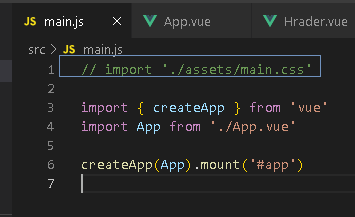

Article.vue
<template>
<H3>Article</H3>
</template>
<style scoped>
h3{
width: 80%;
margin: 0 auto;
text-align: center;
line-height: 100px;
box-sizing: border-box;
margin-top: 25px;
background: #bdbaba;
}
</style>
Item.vue
?
<template>
<H3>Item</H3>
</template>
<style scoped>
h3{
width: 80%;
margin: 0 auto;
text-align: center;
line-height: 100px;
box-sizing: border-box;
margin-top: 25px;
background: #bdbaba;
}
</style>Hrader.vue
<template>
<H3>Header</H3>
</template>
<style scoped>
h3{
width: 100%;
height: 100px;
border: 5px solid #999;
text-align: center;
line-height: 100px;
box-sizing: border-box;
}
</style>Main.vue
<template>
<div class="main">
<H3>Main</H3>
<Article/>
<Article/>
<Article/>
</div>
</template>
<script>
import Article from "./article.vue"
export default{
components:{
Article
}
}
</script>
<style scoped>
.main{
float: right;
width: 85%;
height: 500px;
border: 5px solid #999;
box-sizing: border-box;
text-align: center;
}
</style>Aside.vue
<template>
<div class="aside">
<H3>Aside</H3>
<Item/>
<Item/>
<Item/>
</div>
</template>
<script>
import Item from './Item.vue';
export default{
components:{
Item
}
}
</script>
<style scoped>
.aside{
float: left;
width: 14%;
height: 500px;
border: 5px solid #999;
box-sizing: border-box;
text-align: center;
}
</style>
效果

组件注册
局部注册(建议使用)
在一个组件中进行注册

全局注册
在main.js中全局注册
全局注册很方便,但是在全局注册中,没有被使用的组件无法在生成打包的时候被自动移除(“tree-shaking”),依然出现在打包后的js文件中。
在项目嵌套较多的时候,全局注册的依赖关系不明确,可能影响应用长期维护性。

组件数据传递props
组件之间是可以传递数据,而传递数据的解决方案是props,注:props传递数据只能父级传递子级。
组件传递的数据类型:数字、对象、数字等。任何类型的值都可以作为props的值传递
组件间传递数据应用场景: 父传子

Parent.vue
<template>
<h3>Parent</h3>
<input v-model="msg">
<Child :title="msg" test="数据"/>
</template>
<script>
import Child from './Child.vue';
export default{
data(){
return{
msg:""
}
},
components:{
Child
}
}
</script>Child.vue
<template>
<h3>Child</h3>
<p> {{ title }} </p>
<p>{{ test }}</p>
</template>
<script>
export default{
data(){
return{
}
},
//接收数据
props:["title","test"]
}
</script>传递效果
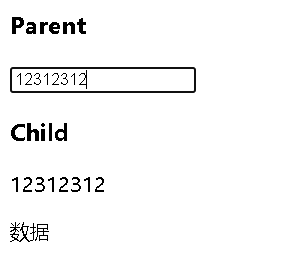
传递数组,对象
Parent.vue
<template>
<h3>Parent</h3>
<input v-model="msg">
<Child :title="msg" test="数据" :names="names" :user="user" :number1="number1"/>
</template>
<script>
import Child from './Child.vue';
export default{
data(){
return{
msg:"",
names:["张三","李四","王五"],
user:{
name:"张三",
age:20
},
number1:123
}
},
components:{
Child
}
}
</script>Child.vue
<template>
<h3>Child</h3>
<p> {{ title }} </p>
<p>{{ test }}</p>
<p v-for="(name,index) of names" :key="index">{{ index }} : {{ name }}</p>
<p>{{ user.name }} {{ user.age }}</p>
</template>
<script>
export default{
data(){
return{
}
},
//接收数据
props:["title","test","names","user"]
}
</script>传递对象

类型验证
<template>
<h3>Child</h3>
<p> {{ title }} </p>
<p>{{ test }}</p>
<p v-for="(name,index) of names" :key="index">{{ index }} : {{ name }}</p>
<p>{{ user.name }} {{ user.age }}</p>
</template>
<script>
export default{
data(){
return{
}
},
//接收数据
props:{
title:{
type:[String,Number,Array,Object]
},
names:{
type:Array
},
user:{
type:Object,
//必选项
required:true
},
test:{
type:String
},
number:{
type:Number,
default:0
}
}
}
</script>Props实现子传父


组件数据传递$emit
组件模板表达式中,可以使用$emit方法触发自定义事件
组件间传递数据应用场景:子传父
Child.vue
<template>
Child
<button @click="clickEventHandle">向父组件发送数据</button>
</template>
<script>
export default{
data(){
return{
msg:"传递数据"
}
},
methods:{
clickEventHandle(){
this.$emit("eventDemo",this.msg)
}
}
}
</script>Parent2.vue
<template>
<Child @eventDemo="getHandle"/>
</template>
<script>
import Child from "./Child.vue"
export default {
components:{
Child
},
methods:{
getHandle(data){
console.log(data)
}
}
}
</script>

组件+v-model

查询:<input type="text" v-model="search">
watch:{
search(newValue,oldValue){
this.$emit("searchEvent",newValue)
}
},
透传
透传attribute指的是传递给一个组件,没有被该组件声明为props或emits的arrtibute或者v-on事件监听器。最常见的例子就是class、id、style。
一个组件以单个元素为根做渲染时,透传的attribute会自动被添加到根元素上
App.vue

Attr.vue
<template>
<h2>透传属性测试</h2>
</template>
<style>
.colorDemo{
color: aqua;
}
</style>效果 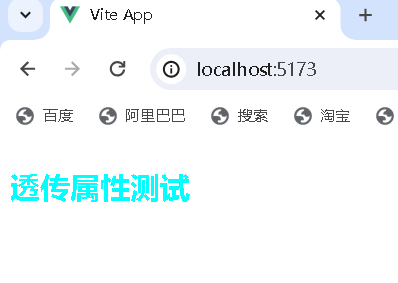
禁用透传attribute
export default{
inheritAttrs:false
}动态组件
<template>
<component :is="tabComponent"></component>
<button @click="changeComponent">切换组件</button>
</template>
<script >
import ComponentsA from "./components/ComponentsA.vue"
import ComponentsB from "./components/ComponentsB.vue"
export default{
data(){
return{
tabComponent:"ComponentsA"
}
},
methods:{
changeComponent(){
// 三元运算符
this.tabComponent= this.tabComponent =="ComponentsA"? "ComponentsB" : "ComponentsA"
}
}
当使用<component :is="tabComponent"></component>在多个组件间切换时,被切换掉的组件会被卸载。可以通过<keep-alive>组件前置被切换掉的组件依然保持“存活状态”
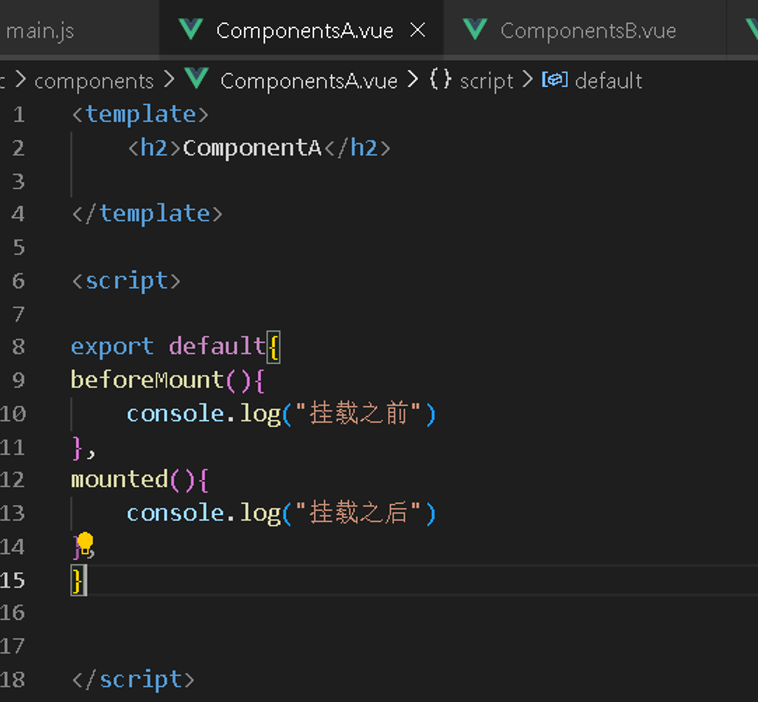
<KeepAlive>
<component :is="tabComponent"></component>
</KeepAlive>

异步组件
Vue提供了defineAsyncComponent实现异步组件功能。
import ComponentsA from "./components/ComponentsA.vue"
//异步加载组件
const ComponentsB =defineAsyncComponent(()=>
import("./components/ComponentsB.vue")
).catch(function(error){
console.log(error);
})

异步组件的优势
1.减少应用程序的初始加载时间
异步组件只有在需要使用该组件时才会进行加载,可以减少应用程序的初始加载时间,提高用户体验。
2.提高应用程序的性能
异步组件可以将组件的加载和渲染分开进行,可以提高应用程序的性能,避免不必要的渲染。
3.优化代码的可维护性
异步组件可以将组件按需加载,可以优化代码的可维护性,减少代码的复杂度。
异步组件的注意事项
1.异步组件的加载时间
异步组件是按需加载的,因此在使用异步组件时,需要考虑组件的加载时间。如果组件的加载时间过长,会对应用程序的性能和用户体验产生影响。
2.异步组件的错误处理
在使用异步组件时,需要对组件加载过程进行错误处理,避免出现错误导致应用程序无法运行。可以通过 catch() 方法来捕获异步加载组件时的错误。
依赖注入-透传
prop逐级透传可以用provide和inject解决这一问题。一个父组件相对于其所有的子组件,会作为依赖提供者。任何子组件树,无论层级多深,都可以注入由父组件提供给整条链路的依赖

App.vue
<template>
<Parent/>
</template>
<script >
import Parent from "./components/Parent.vue"
export default{
provide:{
messages:"app组件"
},
}
</script>Parent.vue
<template>
<h3>Parent</h3>
<Child></Child>
</template>Child.vue
<template>
Child
<p>{{ messages }}</p>
</template>
<script>
export default{
inject:["messages"],
}
</script>效果

动态穿透
<template>
<Parent/>
</template>
<script >
import Parent from "./components/Parent.vue"
provide(){
return{
messages: this.messages
}
},
data(){
return{
messages:"app组件"
}
},
</script>全局数据
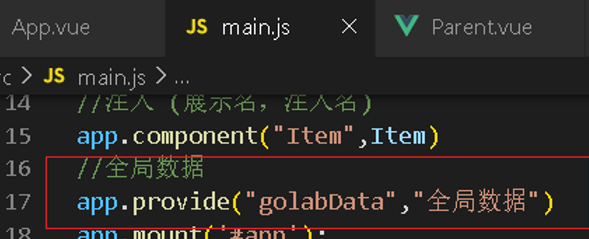
app.provide("golabData","全局数据")
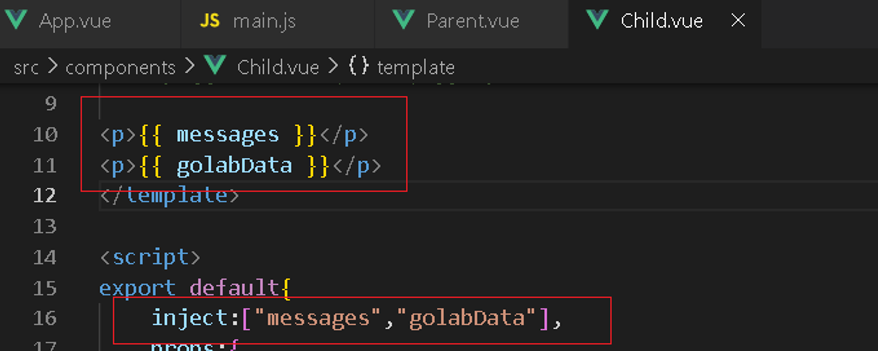
本文来自互联网用户投稿,该文观点仅代表作者本人,不代表本站立场。本站仅提供信息存储空间服务,不拥有所有权,不承担相关法律责任。 如若内容造成侵权/违法违规/事实不符,请联系我的编程经验分享网邮箱:chenni525@qq.com进行投诉反馈,一经查实,立即删除!
- Python教程
- 深入理解 MySQL 中的 HAVING 关键字和聚合函数
- Qt之QChar编码(1)
- MyBatis入门基础篇
- 用Python脚本实现FFmpeg批量转换
- K8S四层代理Service-01
- 8000字程序性能优化全能手册
- 知识付费saas租户平台 :如何用最少的时间获得最大的收益
- 常见位运算模板方法总结(包含五道例题)
- Golang中的深浅拷贝、结构体的拷贝、或可能的深拷贝失败原因
- 数据结构·顺序表应用
- 数据结构实战:变位词侦测
- JAVA基础---抽象类和接口
- Nature Genet|缺氧诱导因子HIF复合体招募组蛋白甲基转移酶SET1B激活缺氧诱导基因
- WiFi7: MLO操作之AP MLD的发现—ML probe request和response的使用

